Toward Long-Term Biodiversity Observation for the Next Generation
What is Nature Positive?
Nature Positive is an international goal that aims to “reverse the loss of biodiversity by 2030 and fully recover it by 2050, compared to 2020 levels. ” Conserving biodiversity is essential to sustainably benefit from ecosystem services, including food, water, and genetic resources.
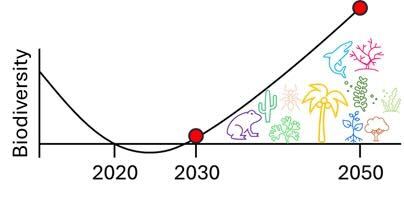
Message from the Project Leader
Biodiversity issues, alongside climate change, represent challenges that will impact future generations, necessitating both sustained research and long-term human resource development over a horizon spanning several centuries. In this research project, we aim to advance 'long-term biodiversity observation' to establish a scientific foundation for biodiversity conservation, alongside 'the development of young professionals' dedicated to achieving a Nature Positive future.
This project period aligns with the critical timeline for realizing Nature Positive’s short-term target to 'halt biodiversity loss by 2030.' Through our work, we seek to assess the progress toward this goal, while also formulating conservation guidelines and preparing the next generation to achieve the long-term objective of 'full recovery by 2050.'
We sincerely appreciate your generous support of our efforts.
Project Leader
Prof. Akira Mori

Biodiversity and Ecosystem Services Science
Research Center for Advanced Science and Technology
The University of Tokyo
Why is Long-Term Biodiversity Observation Important?
There are approximately 2 million known species on Earth, and this diversity is essential to our daily lives. However, it is estimated that around 30% of species are now either extinct or threatened with extinction compared to the year 1,500.
Long-term biodiversity observation provides a scientific foundation for understanding the causes of biodiversity loss and guiding efforts toward a Nature Positive future. These observations help us determine the extent to which biodiversity changes deviate from natural norms and reveal the key factors driving these changes. Long-term observations are especially crucial for detecting shifts in long-lived species, such as trees. While these observations occur over extended timescales, the sites and data collected are invaluable assets for the next generation of young researchers, who study within more limited time frames.
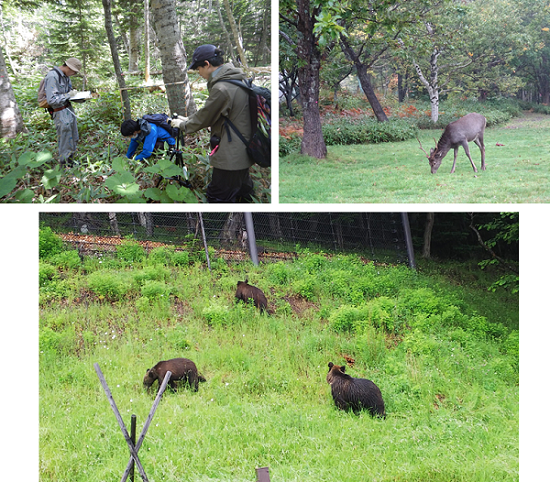
Creating Opportunities for Future Biodiversity Leaders
Nature Positive is a goal for society as a whole, which depends on biodiversity and requires societal transformation to achieve. One concrete example of this is the ongoing effort to integrate biodiversity considerations into economic activities. This includes initiatives such as the Taskforce on Nature-related Financial Disclosures (TNFD), which encourages companies and financial institutions to disclose their dependencies on biodiversity and associated risks, as well as the spread of ESG investments that promote financing for environmentally-conscious companies, including those that prioritize biodiversity.
The youth generation will play a crucial role in the future society where biodiversity becomes mainstream. It is essential to provide opportunities for young people, who will lead future industry and academia, to deepen their understanding of biodiversity.
Through this project, we aim to create opportunities for young people to enhance their understanding of biodiversity by utilizing our long-term biodiversity observation sites. We will welcome student interns and develop educational programs that provide undergraduate to doctoral students with initial exposure to research activities at long-term observation sites through on-site fieldwork and lectures from expert instructors.
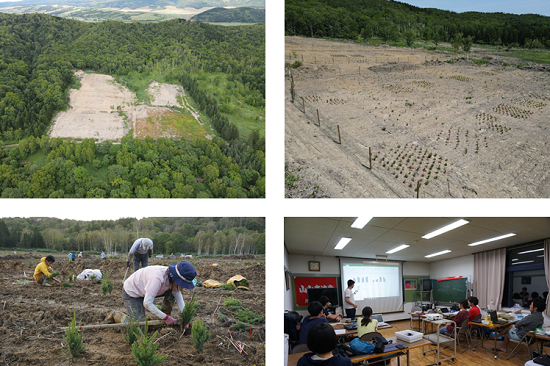
The tree diversity manipulation experiment at Hokkaido University's Teshio Experimental Forest is a collaborative project, both domestically and internationally. With over 10,000 trees planted, the experiment investigates how differences in tree diversity impact forest functioning. Young people gaining experience at such long-term biodiversity observation sites will play a vital role in supporting the mainstreaming of biodiversity in society in the future.
Our Research Objectives
In this project, we will advance 'long-term biodiversity observation' and 'the development of young talent' through three specific research objectives:
1. Forest Restoration in Shiretoko National Park
Shiretoko, located in eastern Hokkaido, Japan, is designated as a UNESCO World Natural Heritage site due to its pristine natural environment and high biodiversity. However, approximately 10% of its land area comprises reclaimed land, with plans to restore these areas to their original forested state. Our lab monitors the biodiversity in the remaining primary forests as a benchmark for restoration. Using the biodiversity of these old-growth forests as a target, we aim to identify efficient and effective methods for restoring the reclaimed areas.
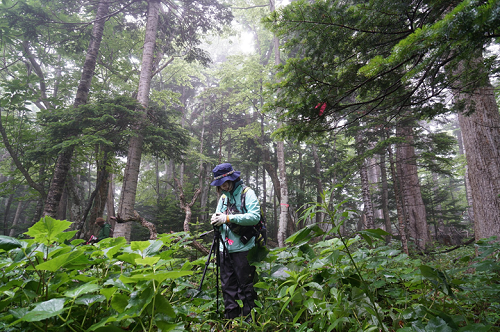
2. Experimental Tests of Tree Diversity and Ecosystem Functioning
Forests with high tree species diversity are believed to exhibit greater and more stable ecosystem functions, such as carbon sequestration, compared to those with lower diversity. However, techniques for establishing and managing highly diverse forests are still under development. To address this, we are conducting a large-scale tree diversity manipulation experiment in collaboration with domestic and international research groups, using Hokkaido University’s Teshio Experimental Forest. This experiment compares ecosystem functions across forests with varying numbers of tree species, planting densities, and spatial arrangements. The scientific insights gained are expected to contribute to the development of planting and thinning methods aimed at creating forests with high tree diversity.
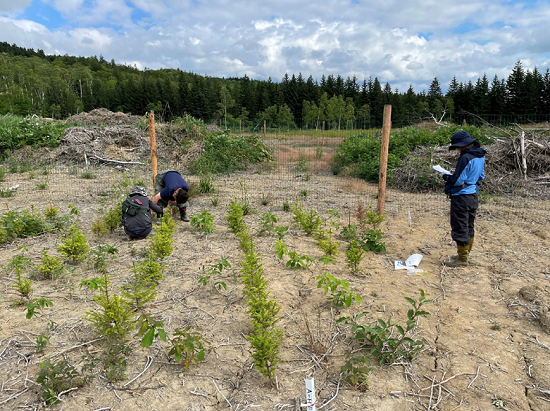
3. Understanding Vegetation Development in the High-Latitude Arctic
One of the regions most affected by climate change is the high-latitude Arctic. Vegetation development following glacier retreat due to warming may contribute to further climate change. Our lab investigates the mechanisms of vegetation development in glacier retreat areas to understand and predict the relationship between future climate change and vegetation dynamics.
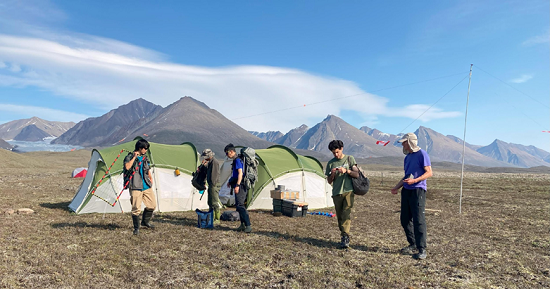
How Your Donations Will Be Used
Your generous donations will be primarily used for the following purposes:
- Fieldwork expenses (such as transportation, accommodation for students, and paid internships)
- Research outreach activities (such as creating VR videos of the Arctic)
- Purchase and maintenance of observational equipment
These are examples, and funds will be allocated as needed based on the contributions received.
Project Member Introduction

The diverse organisms that inhabit our planet each play unique roles, supporting the natural environments in which humans live (BEF: Biodiversity and Ecosystem Functioning). Although we have long benefited from these “gifts of nature” as a given, the emergence of numerous environmental issues in recent years has sparked a global movement to properly recognize and assess the “value” of nature. I have been conducting research to unravel the mechanisms underlying biodiversity and its associated ecosystem functions, collecting data from places like Shiretoko in Hokkaido and the Canadian Arctic. Through this research, I hope to explore sustainable and healthy ways for humans to engage with nature.

I am conducting research to assess the impact of environmental changes on forest composition and structure. Trees live much longer than humans and respond to environmental changes gradually. We may not witness the future of the forests before us today. For this reason, forest management and ecosystem monitoring require a long-term perspective, with efforts that must be sustained across human generations. By inheriting and building upon the invaluable body of observation data carefully accumulated by those before us—a legacy of expertise passed down over time—we can continue nature’s 'health check-ups' to detect changes in ecosystems and biodiversity. To safeguard the health of forests, and ultimately our planet, for the next 100, even 200 years, we sincerely appreciate your support.

Not only the marine but also the terrestrial ecosystem the Arctic harbors. Lives there are suffering from environmental alterations induced by climate change, much more than those in other zones on the earth. Although such stories may seem remote, they are intimately connected with all of us, no matter where we live. Activated microbes will boost greenhouse gas emissions; thawed permafrost is releasing dangerous pathogens and viruses; thrived vegetation provides a shade of green but may simultaneously render global warming more serious. Studying the Arctic terrestrial ecosystems is safeguarding our future.
My current projects focus on spatiotemporal patterns of plant-microbial interactions in the Arctic terrestrial ecosystems. I aim to unveil the organisms' changes driven by climate during the last thousands of years through ancient environmental DNA, understand the mechanisms of primary succession after glacier retreat by investigating plant-soil-microbial interactions on the land exposed from the Last Glacial Period until now on, and explore the contributions of soil microbial community to the ecosystem functions and services in Sub, Low and High Arctic through molecular analysis.
Take the Arctic as a lens through which we can be more aware of the challenges we are facing. I look forward to your support for our future survival, life, and civilization.

My past study has focused on the relationship between hard mast and Asian black bears, as well as seed dispersal by frugivorous mammals. I am currently working in Shiretoko, where I am researching how forest structure affects animal behavior, and also how the spatial arrangement of individual trees affects pollination by animals, endozoochorous seed dispersal, and regeneration. In studying long-lived large mammals, I've realized how important it is to accumulate data and samples to properly understand their ecological role. I feel that continuing the long-term observations begun by previous researchers is critical for effective wildlife conservation and management, which faces with multiple challenges in Japan and around the world..

I am conducting research to develop artificial forests with high tree diversity. Currently, I am involved in an experiment at Hokkaido University’s Teshio Experimental Forest, comparing ecosystem functions between forests composed of a single tree species, like traditional plantations, and those with mixed-species plantings. This experiment was planned and prepared years before I began this research, with past researchers planting over 10,000 trees and meticulously recording growth and manually weeding each year. Thanks to biodiversity observation sites like this one, young researchers, including myself, are able to pursue studies like ours today. I sincerely appreciate your support for this project toward long-term biodiversity observation and the development of young researchers.

In our lab, I primarily analyze data collected from forests. Although the data analysis itself is done on computers in the lab, it relies entirely on the diligent, field-based work of researchers and surveyors on-site. Local data like this provides the foundation for analyses on both a national and global scale. To continue collecting this data over the long term, sustained support and the transfer of knowledge to the next generation are essential. Your support for these studies, which contribute to research worldwide, would be greatly appreciated.

How is Arctic biodiversity formed and maintained? My research focuses on this question from the perspective of soil microbes, which support various ecosystem functions. In 2022-2023, I participated in field surveys and witnessed the severe impacts of warming firsthand, including the high temperature record exceeding 20°C in the Arctic and glaciers that rapidly shrank and dramatically changed shape within just one year—realities I could only fully grasp by being there. My research vision is to utilize biodiversity as an indicator to help predict the worsening impacts of climate change. Through this project, I hope to inspire more researchers to venture to the Arctic and join in tackling this immense challenge. Your support would be greatly appreciated.
Support Our Work
Your support is crucial for continuing our long-term biodiversity observations and nurturing the next generation of biodiversity researchers. By contributing to this project, you're helping to safeguard our planet's biodiversity for future generations.
Thank you for considering supporting our work towards a Nature Positive future.
Related link




